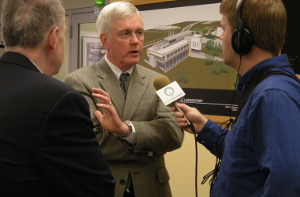GERMinators uncover gloved bacteria

Three sixth-graders from Iowa City’s Shimek Elementary School – known as the GERMinators – investigated pathogens on gloves to determine if they can make people sick. Ari Collins, Anna Mattson and Evan Raefield developed a research project to study how viruses and bacteria grow on gloves, and what can be done to limit their spread. They found disease-causing germs on more than half the gloves they tested.
The project began in October when the GERMinators were selected for the State Hygienic Laboratory’s Student Mentorship Program. Through the program, a Hygienic Laboratory scientist provides project guidance and testing for student science projects that have a laboratory component.
“This Student Mentorship Program allows the interests that have been piqued by the school’s science curriculum an opportunity to be fed and thrive,” said Stephany Cochran, clinical lab technical specialist and mentor for the GERMinators. “Once the seed of curiosity has been planted, we are able to provide a more one-on-one experience that you cannot find anywhere else.”
The laboratory aspect of the GERMinator project was designed to identify and measure the volume of pathogens on gloves worn by students. First, though, the young researchers spent several weeks learning about basic microbiology and laboratory science.
“My light bulb moment happened at the State Hygienic Lab,” said Evan. “We were learning about Gram stains, which help identify a bacteria. All of a sudden, something clicked. I saw how the rest of our project's steps could turn a small idea into a big learning opportunity if we just put in the time and effort.”
More than 200 viruses are to blame for the one billion cases of common cold that occur in the US each year, the National Institutes of Health reports. The leading causes of illness and death in the nation – according to the Office of Disease Prevention and Health Promotion – are influenza and hepatitis, both caused by viruses, and tuberculosis, a bacterial infection.
“As we looked into the details of this project, we found that the science behind it was really mind-blowing,” Anna said.
The GERMinators recruited fellow Shimek students to wear a new glove with their other winter gear during two 25-minute recesses on December 20. As the students came back inside the school, the GERMinators – dressed in lab coats, protective gloves and googles – collected the gloves, swabbed them with a sterile cotton applicator and then used the applicator to streak a petri dish where bacteria could grow for analysis.
From 31 gloves, 113 individual bacterial colonies grew. Of these, about 61 percent could be attributed to those that cause infections or illnesses. The GERMinators and Cochran estimate similar levels for viruses present on the gloves.
“Germs on winter gloves and mittens are no big deal, right? Wrong,” Ari said. “Bacteria and viruses are everywhere in our environment, which is why people know they are supposed to wash their hands to avoid getting sick.
“But most people don’t think about mittens as a way of transmitting germs, even though people are touching the same surfaces with their mittens. If you touch a contaminated mitten to your face, you [may] have just exposed yourself to potential illness.”
The results of the research will be compiled in a Student Mentorship report and also submitted as part of a project application for the U.S. Army eCYBERMISSION challenge. The GERMinator academic advisor for this competition is Hector Ibarra, an inductee of the National Teachers Hall of Fame and former Public Health Ambassador for the State Hygienic Laboratory.
Science takes on new meaning for students who develop such projects, he said.
“Students come to know that the scientific method is a valuable tool in providing solutions to problems present in their community,” Ibarra said. “More importantly, the students realize that as children, adults will listen to their ideas. In the end, their solutions to problems being investigated can make a huge difference.”
The Student Mentorship Program made a difference for Cochran, too.
“I know I am here to help them learn and guide them through this world of scientific unknowns, but at the end of it all, they have helped guide me as well,” she said. “Knowing that they are our future is just astonishing to me. To live life with the excitement I see in their eyes has truly been a blessing.”
And for one GERMinator, the research and new knowledge of laboratory science has been an opportunity to follow her passion for science.
“This project has really opened my eyes to the amazing world of science. It has given me a chance to help my community for the better,” Anna said. “It was incredible to learn about the microscopic organisms that the microbiologists work with.
“Science is my favorite subject and this project has allowed me to do more of what I love. This project has given us more experience with interactive science and really challenged us and showed us what we are capable of.”
To keep up with the GERMinators, follow them on Facebook or check out their website.



